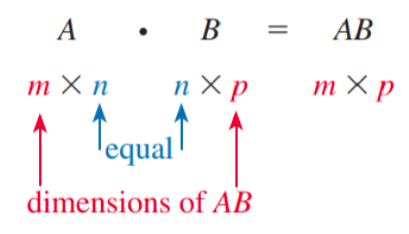Matrices
Lesson 1: Basic Matrix Operations
- Adding and Subtracting Matrices
- A matrix is a rectangular arrangement of numbers
- The dimensions of a matrix with m rows and n columns are m × n (read "m by n")
- The numbers in a matrix are its elements
- Two matrices are equal when their dimensions are the same and the elements are equal
- To add or subtract two matrices, add or subtract their corresponding elements
- Add or subtract matrices only when they have the same dimensions

- Scalar Multiplication
- When working with matrices, a real number is called a scalar
- To multiply a matrix by a scalar, multiply each element in the matrix by the scalar
- This is called scalar multiplication
- Scalar Matrix Equations
- Using the definition of equal matrices, you can equate the elements in corresponding portions of two matrices that are equal
Lesson 2: Multiplying Matrices
- Multiplying Matrices
- The product of two matrices A and B is defined provided the number of columns in A is equal to the number of rows in B
- If A is an m × n matrix and B is an n × p matrix, then the product AB is an m × p matrix

- To find the element in the ith row and jth column of the product matrix AB, multiply each element in the ith row of A by the corresponding element in the jth column of B, then add the products

- Matrix multiplication is not commutative

Lesson 3: Matrix Determinants and Cramer's Rule
- The Determinant of a Matrix
- Determinant of a 2x2 Matrix
- The determinant of a 2x2 matrix is the difference of the products of the elements on the diagonals shown

- Determinant of a 3x3 Matrix
- Repeat the first two columns to the right of the determinant
- Subtract the sum of the red products from the sum of the blue products

- Cramer's Rule
- You can use determinants to solve a system of linear equations
- The method, called Cramer's Rule, uses the coefficient matrix of the linear system

- Cramer's Rule for a 2x2 System
- Let A be the coefficient matrix of the linear system

- If det A ≠ 0, then the system has exactly one solution:

- Note that the numerators for x and y are the determinants of the matrices formed by replacing the values of the x and y coefficient columns, respectively, with the columns of the constant values
- Cramer's Rule for a 3x3 System
- Let A be the coefficient matrix of the linear system shown below

- If det A ≠ 0, then the system has exactly one solution:

Lesson 4: Inverse Matrices
Finding Inverse Matrices
The n x n identity matrix is a matrix with ones for all elements on the main diagonal (top left to bottom right) and zeros for all the other elements
If A is any n x n matrix and I is the n x n identity matrix, then AI = A and IA = A

Two n x n matrices A and B are inverses of each other when their product is the n x n identity matrix; AB = I and BA = I
An n x n matrix A has an inverse if and only if det A ≠ 0
The inverse of A is denoted by A-1
The Inverse of a 2x2 Matrix

Using an Inverse Matrix to Solve a Linear System
Write the system as a matrix equation AX = B; the matrix A is the coefficient matrix, X is the matrix of variables, and B is the matrix of constants
Find the inverse of matrix A
Multiply each side of AX = B by A-1 on the left to find the solution X = A-1B